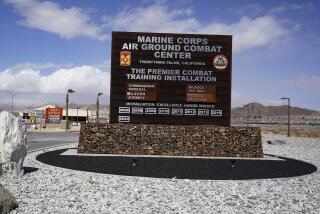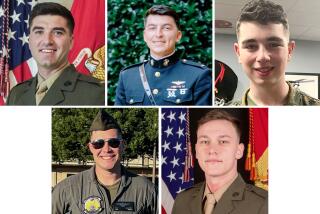Marines Give Training for Rescue Operations Hollywood-Style Flair
- Share via
CAMP PENDLETON — The site looks like a movie lot for disaster films, but the training received by the Marines here is the stuff of recent international headlines, not a screenwriter’s imagination.
Deep in the brushy, rattlesnake-infested hills of this sprawling base, Marines who will deploy soon for six months in the Western Pacific and the Middle East are training for what has become a Marine Corps specialty: rescuing American civilians and other noncombatants from strife-torn Third World hot spots.
“We see that as one of the most likely contingencies we’ll be asked to support,” said Capt. Michael Scalise, humanitarian-assistance support team coordinator for the 13th Marine Expeditionary Unit, which deploys in August.
The Marines’ latest rescue was in May, when personnel from the amphibious assault ship Kearsage evacuated 1,200 people--including U.S. Embassy staff, American civilians and noncombatants from 22 countries--from Sierra Leone as that African nation was convulsed by a military coup.
The evacuation was ordered as mutinous soldiers began looting and teenagers armed with automatic rifles roamed the streets. Three hundred Marines came ashore aboard Sea Stallion helicopters.
The Sierra Leone rescue represented the 10th time in seven years the Navy and Marine Corps had been ordered to mount a noncombatant evacuation operation.
In a recent statement in favor of continued forward deployment of American forces, Gen. Charles C. Krulak, the Marine Corps’ commandant, and Adm. Jay L. Johnson, the chief of Naval Operations, argued that the post-Cold War world will see more brush-fire conflicts and the need for more rescues of Americans caught in the cross-fire.
“Never again will we live in a bipolar world whose nuclear shadow suppresses nationalism and ethnic tensions,” they said. “We have, in some respects, reverted to the world our ancestors knew: a world in disorder. . . . Some might call this period an age of chaos.”
*
At Camp Pendleton, noncombatant-evacuation training takes place at the base’s urban training facility, built in 1993 to simulate a city under siege, complete with overturned cars, bombed-out buildings, an ominously vacant playground and rubble-strewn streets. There are similar facilities at Camp Lejeune in North Carolina and Marine Corps headquarters in Quantico, Va.
The Marines occasionally do the evacuation training in sites near their bases and in foreign locations. Mock rescues have been done at San Diego’s Jack Murphy Stadium--now Qualcomm Stadium--and on a cruise ship in San Diego Bay. Even as the Sierra Leone evacuation was underway, other Marine units were doing evacuation training in Spain.
As with all military training, a premium is put on reality. At Camp Pendleton, Marines dressed in mufti play the roles of opposing religious factions that the American troops must both protect and keep from each other’s throats.
*
Suddenly, members of one faction rush members of the other. The Marines are ordered to break up the melee without taking sides or using force.
Part of the training allows troops to experience the hurry-up-and-wait that has been part of military life since Hannibal crossed the Alps.
“This is how it often goes: It heats up, it cools down, it heats up, it cools down,” said spokesman Capt. Robert “Ogre” McCarthy. “This is very realistic.”
In the mock rescue, Marines playing dazed American civilians need to be rounded up, processed (some play the role of agent provocateurs) and then trucked to waiting helicopters. The training stresses speed and security, moving quickly when the evacuation order comes and ensuring that none of the noncombatants is needlessly put in harm’s way.
Staff Sgt. James Moore said of the evacuation training in which he took part: “It was surgical, sir.”
More to Read
Sign up for Essential California
The most important California stories and recommendations in your inbox every morning.
You may occasionally receive promotional content from the Los Angeles Times.











